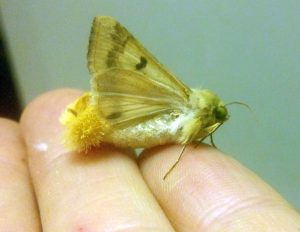Peter Coffey, Agriculture Agent Associate
University of Maryland Extension, Carroll County
plcoffey@umd.edu
If you’re a farmer in the United States then you’re acquainted with the corn earworm, Helicoverpa zea. Maybe you know it as cotton bollworm, tomato fruitworm, sorghum headworm, soybean podworm, or maybe you remember when scientists used to call it Heliothis zea. To keep things from getting confusing we’ll just call it H. zea. No matter what you call it, it’s the same tan colored moth with caterpillars we all remember picking out of the tip of an ear of sweet corn as a kid. As you can guess from the variety of names, H. zea feeds on a lot of different crops. It’s actually been documented to eat over 100 different plants, usually the reproductive part of the plant (the fruit/grain/bean part).

While H. zea is a devastating pest throughout North and South America, it has a bigger badder older brother. In Europe, Africa, Asia, and Australia they also call this moth the cotton bollworm, but it’s a different species, Helicoverpa armigera (we’ll call it H. armigera). In fact, H. armigera is the parent species to our H. zea. Scientists estimate that about 1.5 million years ago some H. armigera moths made their way over to the Americas, and over time they evolved enough that does we consider them to be a different species, H. zea. To put it another way, if dogs evolved from wolves, then H. zea is a bulldog, and H. armigera is the wolf. This is important because H. armigera as the older original species is more genetically diverse, which is probably why it’s better at evolving pesticide resistance.
In recent years, increasing global trade has increased the occurrence of introductions of invasive pests worldwide, and H. armigera has been one of the species that people are the most worried about. It has been caught at the borders several times in North America, but unfortunately in 2013 it was confirmed to be established in Brazil. Additionally, scientists have known for a while that H. armigera and H. zea could mate and create viable hybrids in the laboratory, and just this winter a paper was published documenting the first wild hybrids discovered in Brazil.
Hybrid moths are concerning, because even though H. armigera is the more genetically diverse species, H. zea has spent the last 1.5 million years developing its own unique set of genes. This means that the hybrids combine the genetic diversity of both species. If you’re wondering why genetic diversity is important, remember that when a population lacks genetic diversity we call it inbred, so you could think of hybrids as the opposite of inbred. Scientists worry that these hybrids could attack an even wider range of crops, and that they could evolve pesticide resistance even faster. There’s no reason to think that individual caterpillars would be more damaging, both species are cannibals, which is why you rarely see more than one worm in an ear of corn.
So what does this mean for you? It means that sometime in the future, if these hybrids make it here, pesticide resistance may become even more of a concern than it already is. For now, if you’re spraying corn remember to rotate your chemical families. You can also check out what the corn earworm population is doing at www.mdmothmap.com, or call your local extension office and ask.
